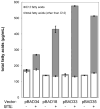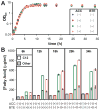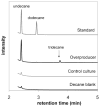A process for microbial hydrocarbon synthesis: Overproduction of fatty acids in Escherichia coli and catalytic conversion to alkanes
- PMID: 20073090
- PMCID: PMC3833807
- DOI: 10.1002/bit.22660
A process for microbial hydrocarbon synthesis: Overproduction of fatty acids in Escherichia coli and catalytic conversion to alkanes
Abstract
The development of renewable alternatives to diesel and jet fuels is highly desirable for the heavy transportation sector, and would offer benefits over the production and use of short-chain alcohols for personal transportation. Here, we report the development of a metabolically engineered strain of Escherichia coli that overproduces medium-chain length fatty acids via three basic modifications: elimination of beta-oxidation, overexpression of the four subunits of acetyl-CoA carboxylase, and expression of a plant acyl-acyl carrier protein (ACP) thioesterase from Umbellularia californica (BTE). The expression level of BTE was optimized by comparing fatty acid production from strains harboring BTE on plasmids with four different copy numbers. Expression of BTE from low copy number plasmids resulted in the highest fatty acid production. Up to a seven-fold increase in total fatty acid production was observed in engineered strains over a negative control strain (lacking beta-oxidation), with a composition dominated by C(12) and C(14) saturated and unsaturated fatty acids. Next, a strategy for producing undecane via a combination of biotechnology and heterogeneous catalysis is demonstrated. Fatty acids were extracted from a culture of an overproducing strain into an alkane phase and fed to a Pd/C plug flow reactor, where the extracted fatty acids were decarboxylated into saturated alkanes. The result is an enriched alkane stream that can be recycled for continuous extractions. Complete conversion of C(12) fatty acids extracted from culture to alkanes has been demonstrated yielding a concentration of 0.44 g L(-1) (culture volume) undecane.
Figures





Similar articles
-
Microbial production of short-chain alkanes.Nature. 2013 Oct 24;502(7472):571-4. doi: 10.1038/nature12536. Epub 2013 Sep 29. Nature. 2013. PMID: 24077097
-
Improving the tolerance of Escherichia coli to medium-chain fatty acid production.Metab Eng. 2014 Sep;25:1-7. doi: 10.1016/j.ymben.2014.06.003. Epub 2014 Jun 13. Metab Eng. 2014. PMID: 24932721
-
Alteration of the specificity and regulation of fatty acid synthesis of Escherichia coli by expression of a plant medium-chain acyl-acyl carrier protein thioesterase.J Bacteriol. 1994 Dec;176(23):7320-7. doi: 10.1128/jb.176.23.7320-7327.1994. J Bacteriol. 1994. PMID: 7961504 Free PMC article.
-
Application and engineering of fatty acid biosynthesis in Escherichia coli for advanced fuels and chemicals.Metab Eng. 2011 Jan;13(1):28-37. doi: 10.1016/j.ymben.2010.10.007. Epub 2010 Nov 4. Metab Eng. 2011. PMID: 21056114 Review.
-
Recent advances in the improvement of cyanobacterial enzymes for bioalkane production.Microb Cell Fact. 2022 Dec 12;21(1):256. doi: 10.1186/s12934-022-01981-4. Microb Cell Fact. 2022. PMID: 36503511 Free PMC article. Review.
Cited by
-
The role of synthetic biology in the design of microbial cell factories for biofuel production.J Biomed Biotechnol. 2011;2011:601834. doi: 10.1155/2011/601834. Epub 2011 Oct 15. J Biomed Biotechnol. 2011. PMID: 22028591 Free PMC article. Review.
-
Improving Escherichia coli membrane integrity and fatty acid production by expression tuning of FadL and OmpF.Microb Cell Fact. 2017 Feb 28;16(1):38. doi: 10.1186/s12934-017-0650-8. Microb Cell Fact. 2017. PMID: 28245829 Free PMC article.
-
Microbial engineering for the production of advanced biofuels.Nature. 2012 Aug 16;488(7411):320-8. doi: 10.1038/nature11478. Nature. 2012. PMID: 22895337
-
Determinants of substrate specificity in a catalytically diverse family of acyl-ACP thioesterases from plants.BMC Plant Biol. 2023 Jan 2;23(1):1. doi: 10.1186/s12870-022-04003-y. BMC Plant Biol. 2023. PMID: 36588156 Free PMC article.
-
Bacterial production of free fatty acids from freshwater macroalgal cellulose.Appl Microbiol Biotechnol. 2011 Jul;91(2):435-46. doi: 10.1007/s00253-011-3344-x. Epub 2011 Jun 4. Appl Microbiol Biotechnol. 2011. PMID: 21643704 Free PMC article.
References
-
- Antoine R, Locht C. Isolation and molecular characterization of a novel broad-host-range plasmid from Bordetella bronchiseptica with sequence similarities to plasmids from Gram-positive organisms. Mol Microbiol. 1992;6:1785–1799. - PubMed
-
- Atsumi S, Hanai T, Liao JC. Non-fermentative pathways for synthesis of branched-chain higher alcohols as biofuels. Nature. 2008;451:86–89. - PubMed
-
- Banerjee A, Sharma R, Chisti Y, Banerjee U. Botryococcus braunii: A renewable source of hydrocarbons and other chemicals. Crit Rev Microbiol. 2002;22:245–279. - PubMed
-
- Bligh EG, Dyer WJ. A rapid method of total lipid extraction and purification. Can J Biochem Physiol. 1959;37:911–917. - PubMed
Publication types
MeSH terms
Substances
Grants and funding
LinkOut - more resources
Full Text Sources
Other Literature Sources

